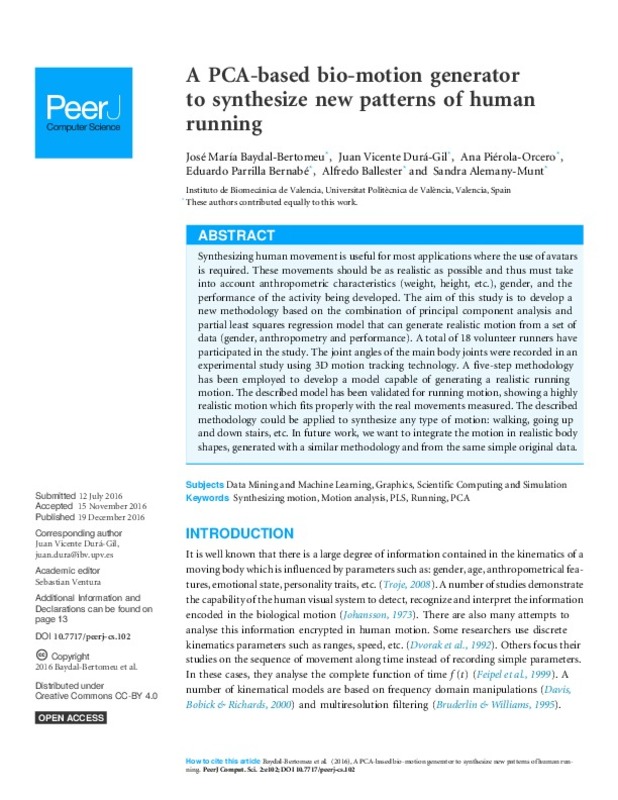JavaScript is disabled for your browser. Some features of this site may not work without it.
Buscar en RiuNet
Listar
Mi cuenta
Estadísticas
Ayuda RiuNet
Admin. UPV
A PCA-based bio-motion generator to synthesize new patterns of human running
Mostrar el registro sencillo del ítem
Ficheros en el ítem
| dc.contributor.author | Baydal Bertomeu, José Mª
|
es_ES |
| dc.contributor.author | Dura Gil, Juan-Vicente
|
es_ES |
| dc.contributor.author | Piérola Orcero, Ana
|
es_ES |
| dc.contributor.author | Parrilla Bernabé, Eduardo
|
es_ES |
| dc.contributor.author | Ballester Fernández, Alfredo
|
es_ES |
| dc.contributor.author | Alemany Munt, Sandra
|
es_ES |
| dc.date.accessioned | 2017-06-23T12:33:49Z | |
| dc.date.available | 2017-06-23T12:33:49Z | |
| dc.date.issued | 2016-11-19 | |
| dc.identifier.issn | 2376-5992 | |
| dc.identifier.uri | http://hdl.handle.net/10251/83565 | |
| dc.description.abstract | [EN] Synthesizing human movement is useful for most applications where the use of avatars is required. These movements should be as realistic as possible and thus must take into account anthropometric characteristics (weight, height, etc.), gender, and the performance of the activity being developed. The aim of this study is to develop a new methodology based on the combination of principal component analysis and partial least squares regression model that can generate realistic motion from a set of data (gender, anthropometry and performance). A total of 18 volunteer runners have participated in the study. The joint angles of the main body joints were recorded in an experimental study using 3D motion tracking technology. A five-step methodology has been employed to develop a model capable of generating a realistic running motion. The described model has been validated for running motion, showing a highly realistic motion which fits properly with the real movements measured. The described methodology could be applied to synthesize any type of motion: walking, going up and down stairs, etc. In future work, we want to integrate the motion in realistic body shapes, generated with a similar methodology and from the same simple original data. | es_ES |
| dc.description.sponsorship | The research for this paper was done within the EASY-IMP project (http://www.easy-imp.eu/) funded by the European Commission FP7.FoF.NMP.2013-5 Project 609078. The funders had no role in study design, data collection and analysis, decision to publish, or preparation of the manuscript. | en_EN |
| dc.language | Inglés | es_ES |
| dc.publisher | PeerJ | es_ES |
| dc.relation.ispartof | PeerJ Computer Science | es_ES |
| dc.rights | Reconocimiento (by) | es_ES |
| dc.subject | Synthesizing motion | es_ES |
| dc.subject | Motion analysis | es_ES |
| dc.subject | PLS | es_ES |
| dc.subject | Running | es_ES |
| dc.subject | PCA | es_ES |
| dc.title | A PCA-based bio-motion generator to synthesize new patterns of human running | es_ES |
| dc.type | Artículo | es_ES |
| dc.identifier.doi | 10.7717/peerj-cs.102 | |
| dc.relation.projectID | info:eu-repo/grantAgreement/EC/FP7/609078/EU/Collaborative Development of Intelligent Wearable Meta-Products in the Cloud/ | es_ES |
| dc.rights.accessRights | Abierto | es_ES |
| dc.contributor.affiliation | Universitat Politècnica de València. Instituto Universitario Mixto de Biomecánica de Valencia - Institut Universitari Mixt de Biomecànica de València | es_ES |
| dc.description.bibliographicCitation | Baydal Bertomeu, JM.; Dura Gil, J.; Piérola Orcero, A.; Parrilla Bernabé, E.; Ballester Fernández, A.; Alemany Munt, S. (2016). A PCA-based bio-motion generator to synthesize new patterns of human running. PeerJ Computer Science. 4:1-16. https://doi.org/10.7717/peerj-cs.102 | es_ES |
| dc.description.accrualMethod | S | es_ES |
| dc.relation.publisherversion | http://doi.org/10.7717/peerj-cs.102 | es_ES |
| dc.description.upvformatpinicio | 1 | es_ES |
| dc.description.upvformatpfin | 16 | es_ES |
| dc.type.version | info:eu-repo/semantics/publishedVersion | es_ES |
| dc.description.volume | 4 | es_ES |
| dc.relation.senia | 333046 | es_ES |
| dc.contributor.funder | European Commission |








